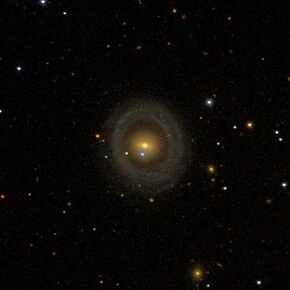| NGC 6028 | |
|---|---|
 NGC 6028 (SDSS DR14) | |
| Observation data (J2000 epoch) | |
| Constellation | Hercules |
| Right ascension | 16h 01m 28.9s[1] |
| Declination | 19° 21′ 36″[1] |
| Redshift | 0.014927[1] |
| Heliocentric radial velocity | 4475 km/s[1] |
| Distance | 62.3 Mpc (203 Mly)[2] |
| Apparent magnitude (V) | 14.35[1] |
| Characteristics | |
| Type | (R)SA0+?[1] |
| Size | ~110,000 ly (35 kpc) (estimated)[1] |
| Apparent size (V) | 1.3 x 1.2[1] |
| Notable features | Structure similar to that of Hoag's Object |
| Other designations | |
| NGC 6046, 1ZW 133, CGCG 108-63, MCG 3-41-43, PGC 56716, PRC C-49, UGC 10135[1] | |
Preview warning: Page using Template:Infobox galaxy with unknown parameter "image_size"
NGC 6028 is a barred[3] lenticular galaxy[4] and a ring galaxy[3] located about 200 million light-years away[4] in the constellation Hercules.[5] Ring galaxies such as NGC 6028 are also known as Hoag-type galaxies as they may have a resemblance to the prototype, Hoag's Object.[3] NGC 6028 was discovered by astronomer William Herschel on March 14, 1784. It was then rediscovered by astronomer Guillaume Bigourdan on May 4, 1886.[6]
- ^ a b c d e f g h i "NASA/IPAC Extragalactic Database". Results for NGC 6028. Retrieved 2017-12-30.
- ^ "parsecs to lightyears conversion". Retrieved 2017-09-30.
- ^ a b c Wakamatsu, Ken-Ichi (January 1990). "On the nature of Hoag-type galaxy NGC 6028 and related objects". The Astrophysical Journal. 348: 448–455. Bibcode:1990ApJ...348..448W. doi:10.1086/168253. ISSN 0004-637X.
- ^ a b "Your NED Search Results". ned.ipac.caltech.edu. Retrieved 2018-01-01.
- ^ "Revised NGC Data for NGC 6028". spider.seds.org. Retrieved 2018-01-01.
- ^ "New General Catalog Objects: NGC 6000 - 6049". cseligman.com. Retrieved 2018-01-01.